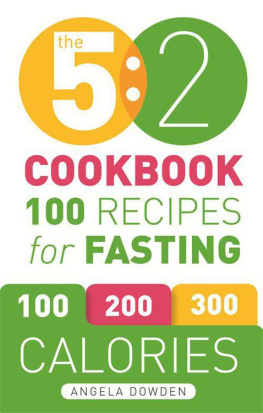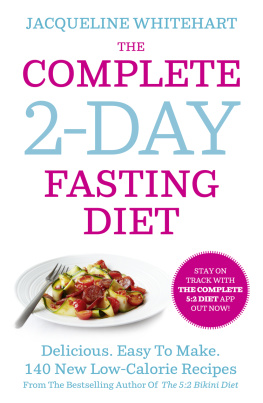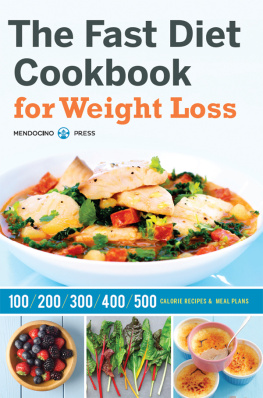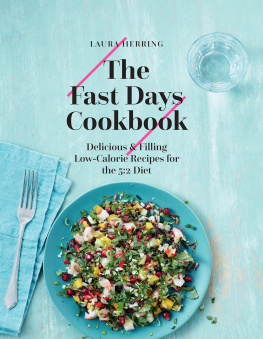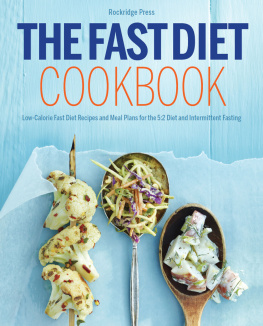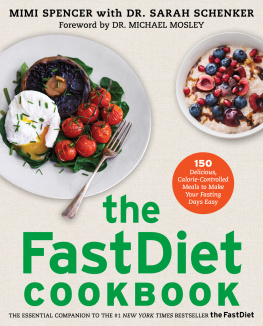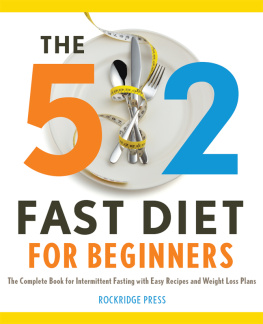5:2 FASTING DIET RECIPES
APP NOW AVAILABLE

The app includes over 80 calorie-counted recipes covering everything from snacks to main meals. It offers a handy calorie counter, to help you keep under your 500- or 600-calorie limit and still eat tasty food.
1.99
Buy your copy now!

Angela Dowden is a registered nutritionist who writes on diet and health for numerous newspapers and magazines. She was awarded the Nutrition and Health Writer/Broadcaster of the Year award in 2012.
An Hachette UK Company
www.hachette.co.uk
First published in Great Britain in 2013 by
Hamlyn a division of Octopus Publishing Group Ltd
Endeavour House, 189 Shaftesbury Avenue, London WC2H 8JY
www.octopusbooks.co.uk
Copyright Octopus Publishing Group Ltd 2013
All rights reserved. No part of this work may be reproduced or utilized in any form or by any means, electronic or mechanical, including photocopying, recording or by any information storage and retrieval system, without the prior written permission of the publisher.
ISBN 978-1-84601-452-9
A CIP catalogue record for this book is available from the British Library
Both metric and imperial measurements are given for the recipes. Use one set of measures only, not a mixture of both.
Standard level spoon measurements are used in all recipes
1 tablespoon = 15 ml
1 teaspoon = 5 ml
Ovens should be preheated to the specified temperature. If using a fan-assisted oven, follow the manufacturers instructions for adjusting the time and temperature. Grills should also be preheated.
This book includes dishes made with nuts and nut derivatives. It is advisable for those with known allergic reactions to nuts and nut derivatives and those who may be potentially vulnerable to these allergies, such as pregnant and nursing mothers, invalids, the elderly, babies and children, to avoid dishes made with nuts and nut oils.
The Department of Health advises that eggs should not be consumed raw. This book contains some dishes made with raw or lightly cooked eggs. It is prudent for more vulnerable people such as pregnant and nursing mothers, invalids, the elderly, babies and young children to avoid uncooked or lightly cooked dishes made with eggs.
CONTENTS

Introduction
If youve picked up this book you may already be a convert to intermittent fasting. Alternatively, you may have heard about its benefits and are wondering whether to give it a go. At the other end of the scale you may be a battle-weary diet sceptic, still holding out a small hope youll one day find the way to shape up and feel healthier permanently. Whatever your starting point or motivation, if you have a small or large amount of weight to lose and would like to feel more comfortable in your own skin, its for you too.
So what is the 5:2 approach to weight loss and how does it work? There are any number of ways people practise intermittent fasting, from one day of light eating a week to no food at all for several days in a row. The 5:2 approach works well for most people because its a pragmatic solution that steers a safe, doable and yet effective path through these extremes.
How to use the book
The 5:2 plan allows normal eating (including treats and meals out) for five days a week and then restricts calorie intake to 500 calories a day for women and 600 calories for men (a quarter of the normal recommended daily intake) for the other two. For most people, its the perfect compromise that allows for socializing, family life and work commitments, while still introducing enough calorie control to make sure you lose weight at a healthy rate.
With its delicious and innovative recipe selection, this book shows just how flexibly you can consume your 500 or 600 calories to keep the hunger wolf from the door and, yes, even tickle your taste buds at the same time! It also includes some sweet treats, but they are perfectly suitable for a fast day as theyre not too high in sugar.
Ultimately, youll be losing weight as can only ever be the case by eating, overall, fewer calories than your body uses up. But where the 5:2 diet is particularly brilliant is how marvellously achievable it can make this task for food lovers. People who find success with 5:2 often report that they failed to lose weight in the past because cutting back every day was such a struggle doing so for just a couple of days a week, albeit more drastically, is a much more attractive proposition.
Better still, far from being a short-term fad, those who practise intermittent fasting find it is a lifestyle choice that they can stick to because it doesnt take over their whole life, doesnt demonize specific foods and can even run alongside other supportive weight-loss regimens, such as online food diary methods.
As to the health benefits? As you lose body fat and get trimmer, you can expect to greatly reduce your chance of having a heart attack or developing heart disease.
And, in strands of research unrelated to the weight-loss benefits, theres a growing groundswell of science that shows that periodically putting your body into a fasted state may cause various chemical changes linked with lower risk of age-related diseases and higher chance of living healthier for longer.
Whether youre a 5:2 fan in search of food inspiration, or just intrigued to know more, youll find something in this book for you. Read, digest, get slimmer and enjoy!
IS THE 5:2 DIET FOR EVERYONE?
Most overweight adults can benefit from a 5:2 diet, but it should never be embarked on by children or adolescents, for whom any form of nutritional stress is undesirable. Also, do not do the 5:2 diet if any of the following apply (check with your medical practitioner if you are uncertain).
- You are pregnant, trying to get pregnant or breastfeeding.
- You are already at the bottom end of your healthy weight. You can check this using an online Body Mass Index (BMI) calculator (see ) a BMI of 20 or less would indicate you are not a candidate for 5:2, or indeed any weight-loss programme.
- You are an elite athlete or in training for a marathon or other big stamina event (although normal levels of activity can be undertaken on the 5:2 diet ).
- You are diabetic.
- You have irritable bowel syndrome
- You have been diagnosed with an eating disorder, either recently or in the past.
How does intermittent fasting work?
People have fasted out of choice or through necessity for millennia, so the general concept is far from new. Interest was roused in the 1930s (and repeatedly since) when scientists found that restricting the calories fed to various animals and insects increased their lifespan. The idea of severely restricting calories every other day rather than by a smaller amount every day came later, in 2003, with laboratory research carried out at the National Institute on Aging (NIA) in America. The concept of intermittent fasting and more specifically the 5:2 diet for managing weight reached a mass audience when Dr Michael Mosley presented the theories in a BBC Horizon programme aired in August 2012.
The IGF-1 advantage
Most people are more than happy with the tangible benefits a flatter stomach and streamlined thighs that intermittent fasting can bring. But experts are interested in what it may do to our internal chemistry, in particular a hormone called IGF-1, or insulin-like growth factor. IGF-1 is important for growth when we are young but, in adulthood, lower IGF-1 levels are better, as they are linked with a less rapid turnover of cells and, potentially, a decreased cancer risk.

